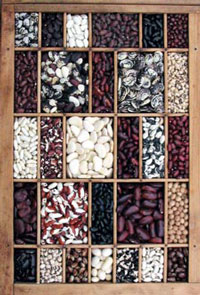My annual winter seed catalog immersion has officially begun, and as usual it is promising to be a rich educational experience. Every winter as I read and re-read the dozens of seed catalogues that come in the mail, I learn a ton about about seed histories, vegetable diversity, and food traditions.
If you are a beginning gardener, I recommend getting on the mailing lists of good seed companies, particularly those selling open-pollenated and heirloom varieties. Good seed catalogues are fabulous sources of gardening information, food lore, and growing tips.

At left: A few heirloom bean varieties from the Saving Our Seeds collection.
I love heirloom beans, and have grown several beautiful and delicious dry bean varieties over the years and fantasized about growing a whole lot more.
I have about 35 particular bean varieties on my lifetime bean-growing wishlist. And the list keeps growing.
Jacob's Cattle. Hutterite Soup. Black Valentine. Indian Woman Yellow. Amish Gnuttle. Even the names are magical to me. I've spent hours poring over bean listings in the Seed Savers Exchange catalogue and reading about the histories of the hundreds (thousands?) of bean varieties that exist. What I am saying is that I am a major heirloom bean dork (See previous posts on Local Protein and Cherokee Trail of Tears Beans for more evidence of this...)
So imagine my surprise when I discovered Tepary Beans (the aformentioned whole new species) a type of bean more ancient and storied than any of the heirlooms I've ever known. Three varieties of Tepary Beans were listed in a sidebar in the Seeds of Change catalog, along with the botanical name of the species: Phaeseolus acutifolius. This was enough to send me down the google rabbit hole in search of more information about the mysterious Tepary.
Here's what I found: Tepary Beans are pre-Colombian heirlooms with flavors and growing habits distinct from other beans. They were cultivated throughout dry areas of what is now the Southwestern US, Mexico, and Central America, selected from native beans and grown for thousands of years by ancient peoples.
I found much more in a Seeds of Change newsletter article by Jay Bost:
"While most beans that we eat belong to the species Phaeseolus vulgaris and are native to South America, tepary beans belong to an entirely different species, Phaeseolus acutifolius, which grows wild in the Sonoran Desert, with local populations currently documented on Isla Tiburon in the Sea of Cortez and in the Santa Maria mountains of Arizona (Nabhan 1985). As long ago as 8,000 years ago, the native peoples of the Sonoran Desert began to domesticate wild tepary beans, which, until quite recently, were eaten by some in Mexico, along with Phaeseolus filiformis, another wild desert bean."

Bost details the history of Tepary Beans, and the reasons that they are apparently experiencing something of a revival.. He says that Teparies "are considered by many to be the most drought-tolerant annual legume in the world" and "are capable of producing a harvest of beans with a single rain." We've been in a severe drought for the last two years here in Western North Carolina, so a bean that can grow without irrigation is an exciting discovery indeed.
Bost's article also details the nutritional appeal of Teparies:
"Part of the tepary bean's appeal, in addition to its drought tolerance, is its superior nutritional content. It has a higher protein content (23–30%) than common beans such as pinto, kidney, and navy, as well as higher levels of oil, calcium, iron, magnesium, zinc, phosphorus, and potassium."
Bost's overview is great - you can read the whole article here.

So I've added Sonoran Gold Tepary Beans (pictured above, courtesy of Seeds of Change) to my bean wishlist. It's a dry soup bean developed by the Papago people, and contains more than 30% crude protein.
We'll plant some in the spring and see how they taste. Stay tuned for further adventures in seed catalogue reading.
3 comments:
Just a word of warning, Milkweed, re: teparies: they can carry mosaic virus that can be transmitted to all those other beans. I'd looked into them too a few years back and changed my mind: Love my beans too much to grow only one kind!
el, THANKS for the warning.
I hadn't come across the info about mosaic virus in my reading.
But your comment spurred more research, and I notice there are some varieties that are supposed to be "virus free" - here's one: http://www.backyardgardener.com/plantname/pda_9d3a-2.html ....
I'll read up some more and post any more info I come across...
Thanks again!
I grew some Mitla Black tepary beans this past year (also from Seeds of Change) and liked them a lot. Haven't eaten them yet (I didn't grow a lot so they're only going to make one meal), but they grew without any trouble or disease or extra watering, and are very pretty.
Post a Comment